As the size of your blog or website grows, you’re bound to end up with a number of similar or overlapping pieces of content. But it’s a common misconception that you need to have a number of very similar or nearly identical articles on your website in order to rank for a desired keyword. In fact, having multiple pages about the exact same topic on your website can cause more harm than good and have a negative impact on search engine rankings.
Having multiple versions of the same page or blog post, even if they’re slightly different, can lead to what is known as keyword cannibalization. Keyword cannibalization occurs when multiple pages on a website are ranking for the same search queries in Google. In other words, the site is competing with itself and, in the process, confusing Google about which of its pages should rank for the desired search term.
Unfortunately, when Google is confused about which of a website’s pages to rank, the organic performance of both pages may suffer, and both will typically rank lower in search than they otherwise would. So keyword cannibalization will actually cause a website to receive less search traffic for a given term than it should.
In this article, I’ll highlight an example of keyword cannibalization, provide tips for spotting cannibalization on your website, and show you how to implement fixes today.
Why Is Keyword Cannibalization Bad?
Let’s look at a real-life example of keyword cannibalization. As mentioned above, keyword cannibalization happens when you have two very similar articles, each of which has been optimized for the same or very similar primary keywords.
I just did a quick Google search for “best pet insurance” and found a cannibalization issue happening on MarketWatch, a website about consumer finance and financial products:
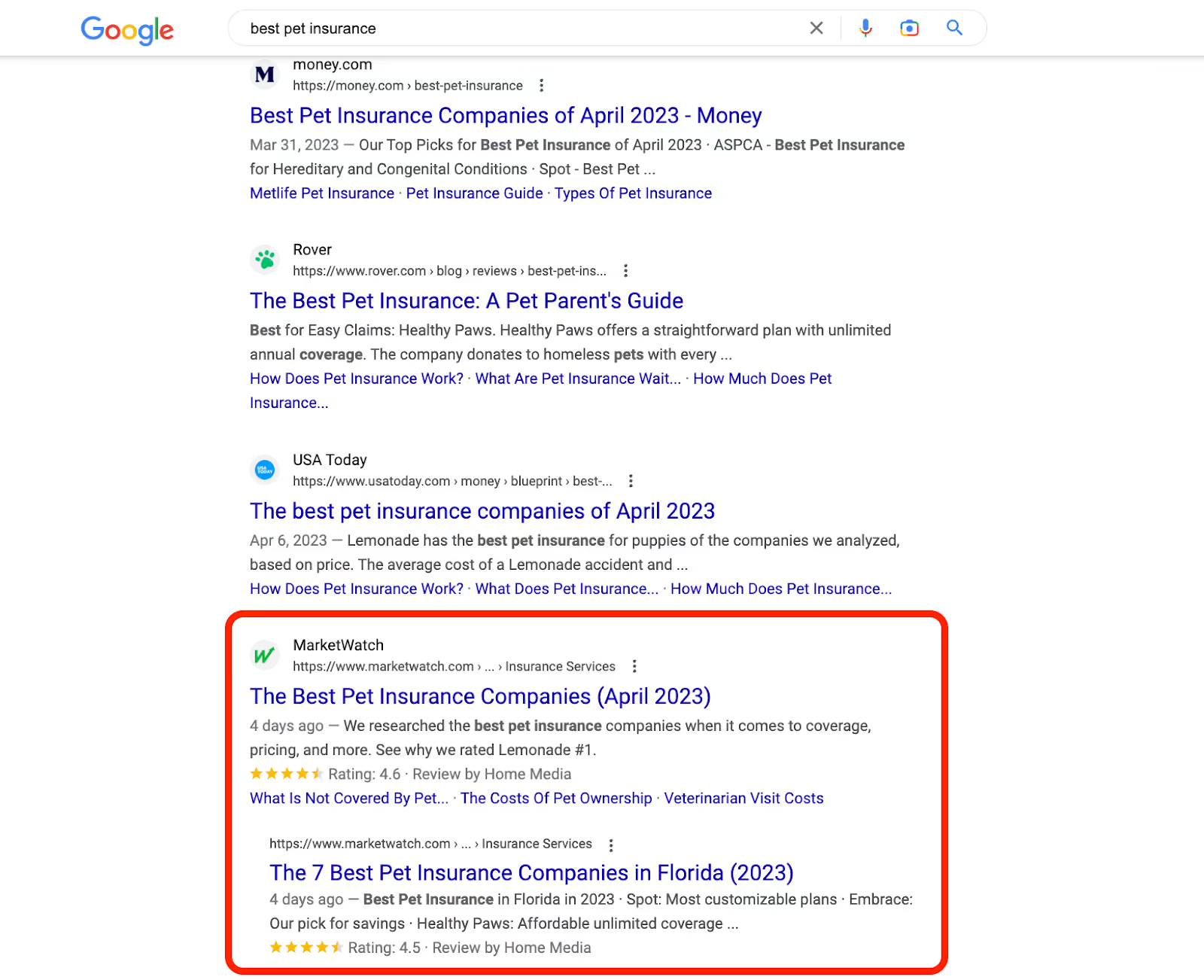
MarketWatch is currently in the eighth and ninth search ranking positions for the keyword “best pet insurance”.
As seen above, MarketWatch is ranking with a general page titled “The Best Pet Insurance Companies (April 2023)” and with an article titled “The 7 Best Pet Insurance Companies in Florida (2023).” I’m not located in Florida, by the way, so a regional search here wouldn’t explain why a page about Florida is ranking for me.
As you might suspect, the content on these pages is nearly identical. Both pages have identical reviews for the same seven pet insurance companies. It turns out that the best companies in Florida are also the best companies for the nation, according to MarketWatch.
Because these pages are so similar, Google is unsure which page to prioritize in search. MarketWatch has high domain authority, so they are more capable of ranking multiple pages on the first page for the same keyword, whereas a website with lower authority likely wouldn’t be able to hit the first page with two pages cannibalizing each other for this competitive keyword.
MarketWatch has higher domain authority than most of the pages currently ranking above it; however, because MarketWatch has published two nearly identical pages, Google doesn’t know which to prioritize, and unfortunately, the primary page is likely suffering in rankings as a result. When Google is confused in this way, they will typically rank both pages lower than they otherwise would.
In this case, MarketWatch should work to make the Florida-specific page more unique and actually tailored to a searcher in Florida, and not identical to the general page they’re trying to rank for all geos. Due to this cannibalization issue, MarketWatch is likely ranking lower than it otherwise would, and they are driving less overall traffic as a result.
How to Spot Keyword Cannibalization
Keyword cannibalization can be difficult to detect, and it becomes increasingly difficult as your website grows in size. On my websites, I’ll typically check for cannibalization across all of my pages once per quarter as part of my technical SEO audit. In my experience, there are three ways to spot cannibalization:
- Perform a Content Audit (Small Sites)
- Use Site: Search
- Use Ahrefs to Look at Historical Rankings
In this section of the article, we’ll explore all three of these options.
Perform a Content Audit (Small Sites)
If you have a small number of pages on your website — 20 to 30 pages, for example — I’d start by performing a manual content audit. A content audit is simply a review of all of the content published on your website. In my content audits, I typically note the primary or intended keyword that each article on my website should rank for.
Do you have multiple pages targeting very similar keywords? Do you have a large number of thin pages?
If so, flag them and move on to the next two steps.
Use Site: Search
After you’ve identified pages that could be cannibalizing one another, the next step is to go to Google and use the site: search function.
For MarketWatch, I went to Google and did a site: search on marketwatch.com for “best pet insurance”:
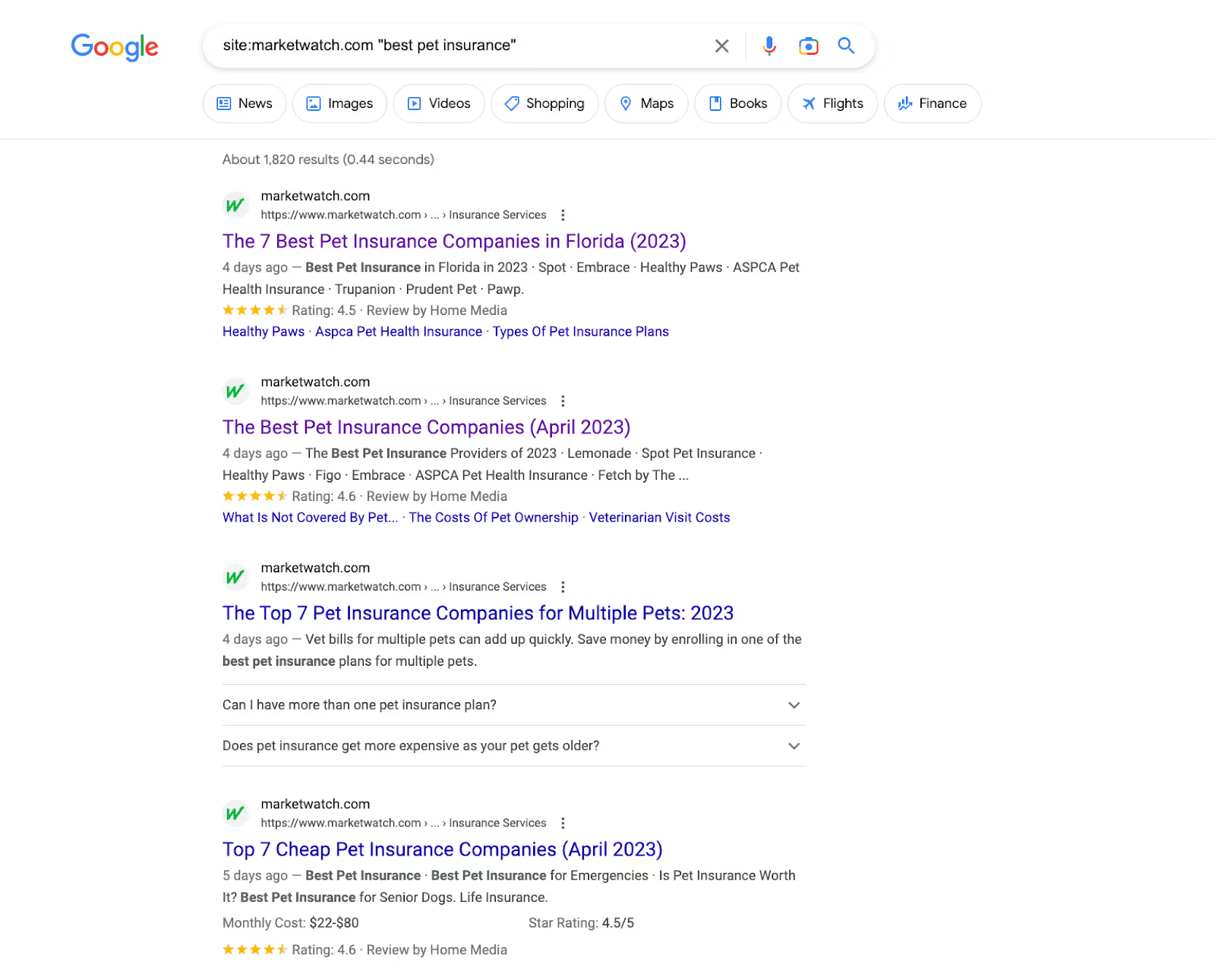
As I suspected, the first two results from this search are the two pages in question, and they are cannibalizing each other. But it turns out that MarketWatch has a very large number of similar pages. In this case, they have specific best-of pages for multiple pets, for cheap coverage, and for a number of other states, including South Carolina and California.
All of these pages are nearly identical in terms of content. The H1s are different; however, the body copy is nearly identical except for small changes to the first-paragraph intros.
MarketWatch has a number of different pages that could all be cannibalizing one another in search. If MarketWatch were ranking highly, for example, in the first and second spots, well, this wouldn’t be an issue. The problem is that this confusion is causing MarketWatch to rank abnormally poorly for both variations of these keywords.
But how can we know for sure? Ahrefs has a powerful toolset for analyzing cannibalization over time.
Use Ahrefs to Look at Historical Rankings
Ahrefs is a popular toolset for content marketing teams. At Positional, we have no affiliation with Ahrefs, but I’m happy to highlight their toolset for keyword cannibalization here.
If I enter “marketwatch.com” into Ahrefs’ Site Explorer, then go to the Organic Keywords report, and then filter for “best pet insurance,” I can plainly see keyword cannibalization:
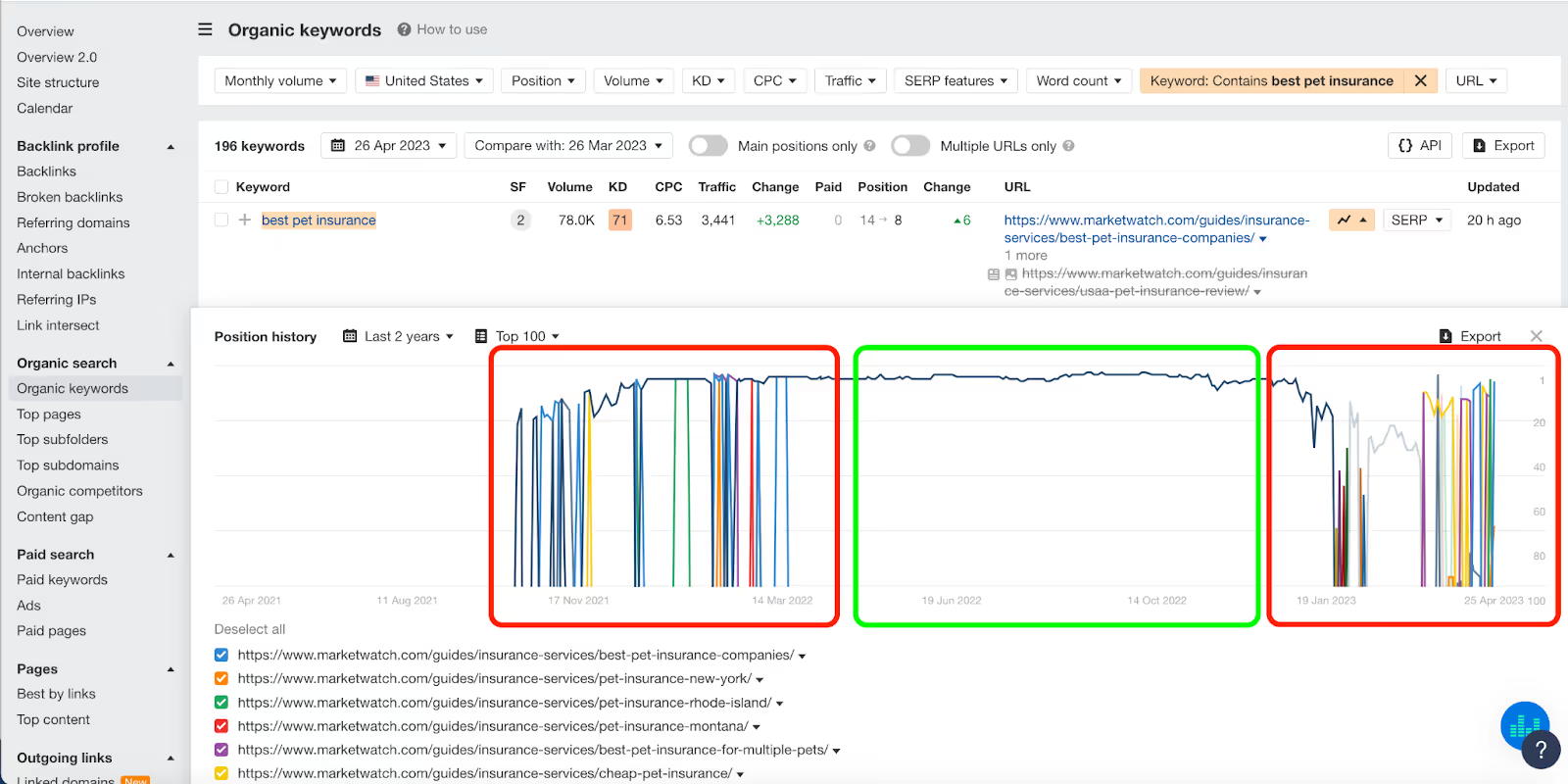
Ahrefs will show the number of pages ranking for each given keyword, and they will show you the movement of each of these pages over time. It turns out that there are actually 17 different pages on their website ranking for the keyword “best pet insurance” at different times over the past two years.
In the first red box, on the left-hand side, we see cannibalization in action. There are a number of different pages overtaking rankings for this keyword, and the page ranking is flip-flopping. However, in the green box, which shows June 2022 to November 2022, there actually isn’t any cannibalization shown, as MarketWatch was ranking their primary page for the generalized keyword. Then, in January 2023, rankings started to drop off significantly for the primary page. And since then, MarketWatch has experienced a significant increase in cannibalization and volatility in rankings.
MarketWatch could improve the performance of its main page about the best pet insurance options by removing duplicate content from a large number of similar pages. In addition, MarketWatch could improve the geo-specific pages by making them actually helpful for searchers in those areas.
How to Fix Keyword Cannibalization
Fixing keyword cannibalization often takes some trial and error. Cannibalization could be caused by a number of issues, like duplicative content, improper use of internal links, and pages being over-optimized for identical terms. Here, I’ll highlight three steps to take if you’re experiencing cannibalization issues.
Combine and 301 Redirect Similar Content
I’m a big believer that each article on your website should serve a single primary purpose or keyword. If there are two articles serving the same purpose and targeting the same audience and keyword, you could combine these articles into one fantastic article.
I’d start by determining which of the two pieces of content is of higher quality. Next, I’d look to see if the higher-quality piece could benefit from including additional content from the secondary piece. If so, I’d work to combine these two pieces of content into a single article.
After combining the pieces of content, you will want to 301 redirect the secondary URL over to the primary URL. A 301 is an HTTP response status code that tells search engines that the location of the URL has permanently changed.
In the case of MarketWatch, they may want to consider merging their page that covers the best cheap pet insurance page into their general page about the best pet insurance. And on that page about the best pet insurance, they could add a new section about cheaper options or plans.
They would then 301 redirect https://www.marketwatch.com/guides/insurance-services/cheap-pet-insurance/ over to https://www.marketwatch.com/guides/insurance-services/best-pet-insurance-companies/.
Optimize Internal Links and Use More Specific Anchors
Internal links play an important role in your site structure. Internal links help Google understand what each page on your website is about and the keywords the page is intended to rank for. Optimizing anchor text and internal link placement can help signal to Google how pages are uniquely different from one another.
If you have similar but different pages on your website, you should try re-optimizing anchor text on the internal links pointing to the pages in question. In my experience, being more specific with your anchor text, and using anchor text to highlight the differences in these pages, can help Google identify how these pages are different and which sets of keywords each page should rank for.
If anchor text doesn’t help, you could also try removing internal links to less important pages that are cannibalizing pages of higher importance. Internal links help signal to Google which pages on your website are important. And if you’re internally linking to a large number of unimportant pages, you could consider removing internal links to these pages and then adding internal links to the pages you’d like to rank instead. You could also consider, as previously mentioned, merging unimportant pages or noindexing them.
Re-Optimize Pages for Different but Similar Keywords
Depending on the niche you’re in, there may be a large number of similar but very different keywords. If you are experiencing cannibalization, you could try re-optimizing the content itself to more closely match the target keyword.
In the case of MarketWatch, they are attempting to rank for different variations of the primary keyword with location-based modifiers.
However, as we’ve described, the content on the pages themselves is nearly identical from one page to the next. In a case like this, if you’re building location-based variants, you’ll want to beef up those pages with the specific audience in mind.
MarketWatch’s page about the best pet insurance in Florida doesn’t actually better serve a visitor in Florida. I’d encourage MarketWatch to add additional context for a searcher actually in Florida. For example, perhaps coverage and policies differ for a customer in Florida. Alternatively, maybe there are local or regional providers in Florida that are different from the generic seven companies highlighted on the website’s identical pages.
You can also experiment with modifications to the headers, including H1s, H2s, and H3s, to more clearly communicate to Google the differences in these pages. MarketWatch might consider adding a new header or section for a city in Florida — Miami, for example.
When to Combine Pages and When to Split Two Primary Keywords in New Content
Great! Now that we’ve fixed the cannibalization issues happening in our existing portfolio of content, we’ll want to reduce the chance of cannibalization happening again as we create new content for our website.
A difficult question I’m often asked is when to combine keywords in a single standalone article and when to split keywords into multiple separate pieces of content.
While this question is a tricky one, answering it is sometimes quite simple. Here’s how: Go to Google and look at the top five results for each variation of the keyword. If the results are the same, you should combine these related terms into a single article. However, if the top five results are different and tailored to a different set of keywords, you should split those keywords into different articles.
For example, if I were creating an editorial calendar for a website in the diabetes niche, I’d likely want to rank for keywords related to type 1 diabetes symptoms. And in my research, I noticed a number of related search terms regarding type 1 diabetes symptoms in women.
Should I create a single article targeted at both of these variants: “type 1 diabetes symptoms” and “type 1 diabetes symptoms in women”?
Or should I split these two keywords out into two different articles?
Search Results for “Type 1 Diabetes Symptoms”:
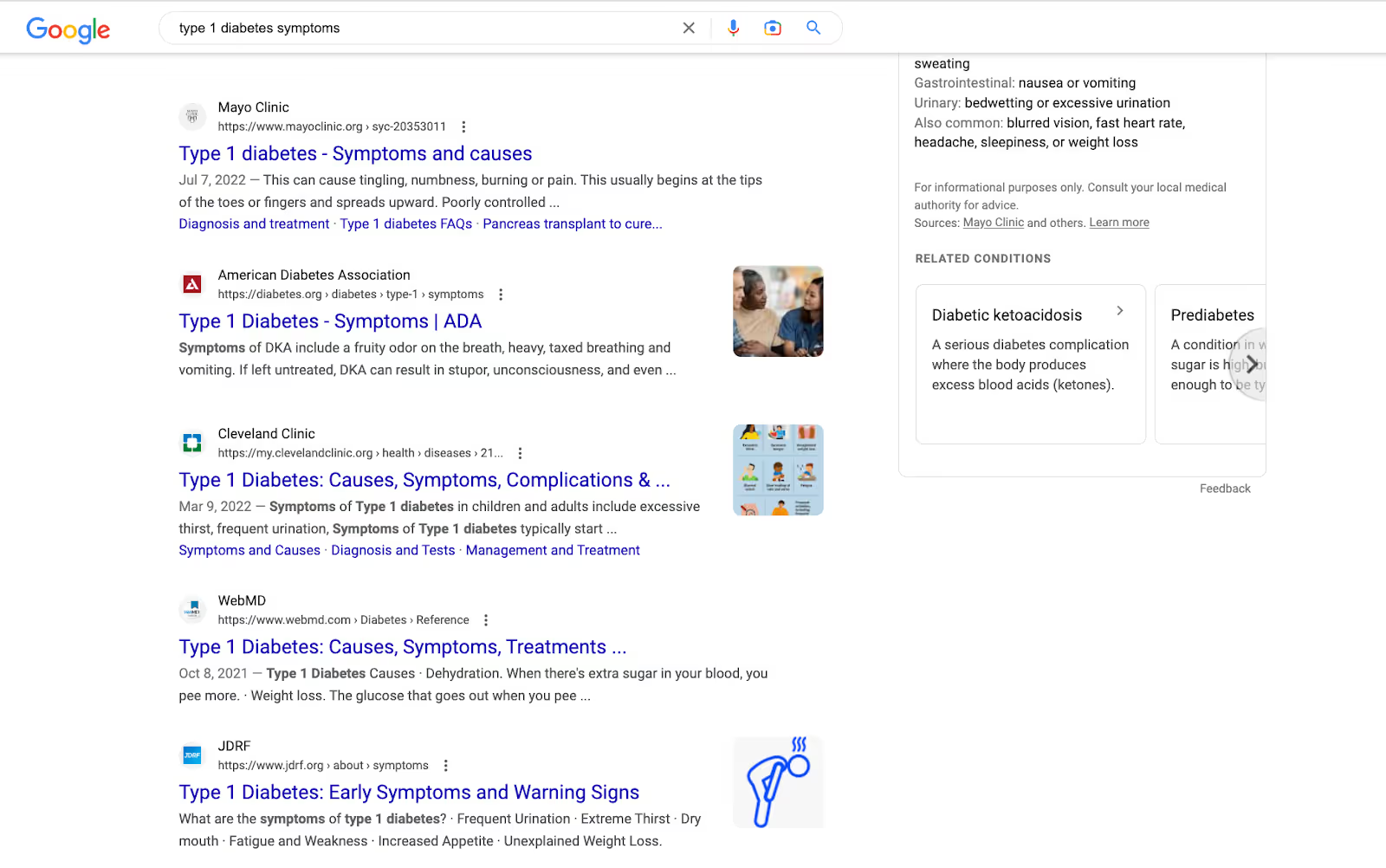
Search Results for “Type 1 Diabetes Symptoms in Women”:
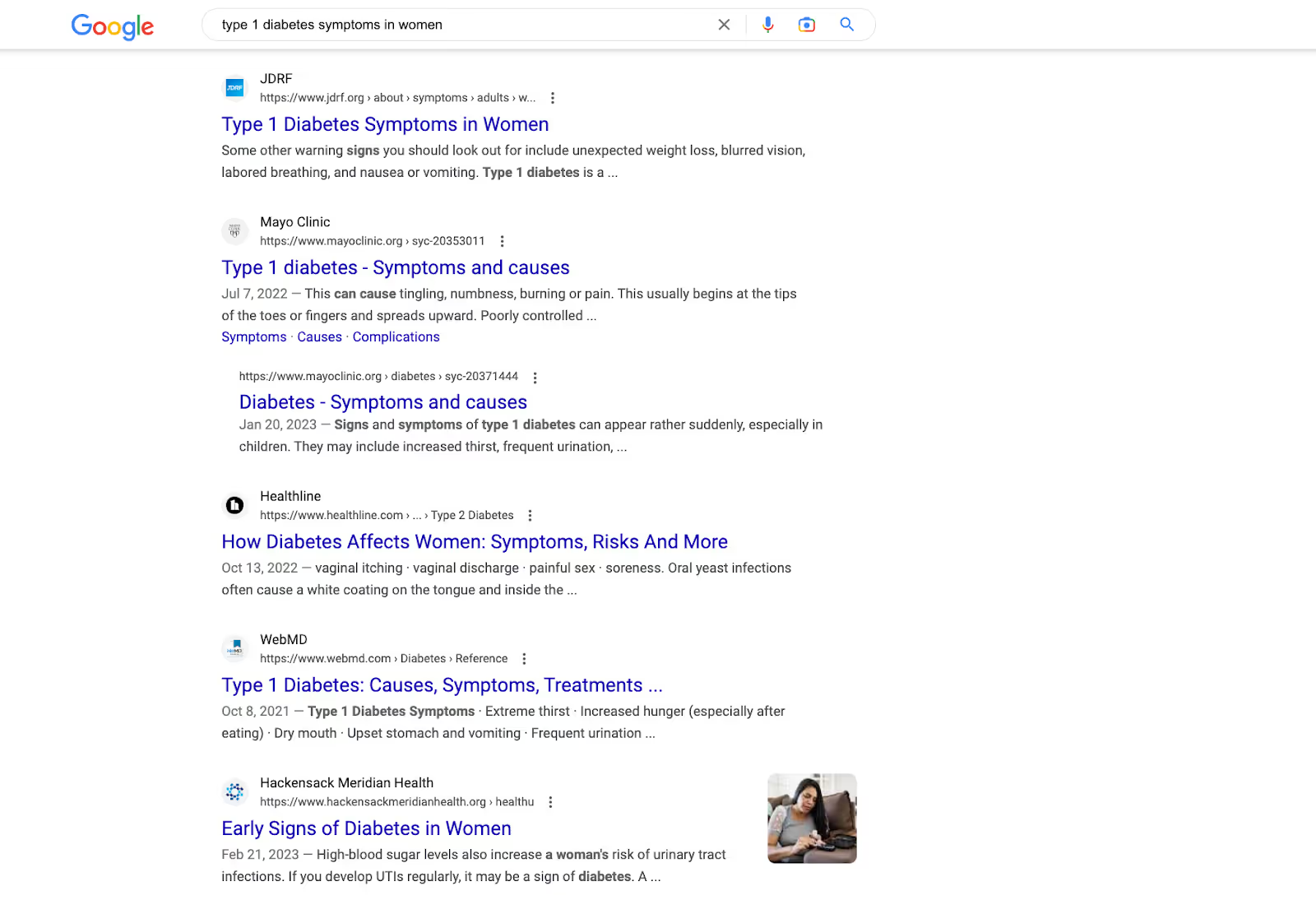
In the first set of results, we see that the top five results for “type 1 diabetes symptoms” included only broad or generic results, without mentions of specific populations like women, men, or children.
However, in the second set, we see that some of the top five results for “type 1 diabetes symptoms in women” are actually tailored to this specific variation: three out of the top five results, including the first result.
In this example, you’d want to split these two separate topics into two standalone blog posts. By performing this analysis upfront, you can reduce the risk of future cannibalization issues.
Final Thoughts
Keyword cannibalization is one of those challenges that we all face at some point or another. If you are experiencing cannibalization, know that your search rankings are likely suffering as a result.
It can be difficult to know where or how often cannibalization is happening across a website. I’d start by doing a manual content audit to look for possible overlap between primary keywords on multiple articles. Next, you can use Google’s site: search functionality to get a sense of how Google may be viewing similar pages on your website. Finally, you can use a tool like Ahrefs’ Organic Keywords tab to view cannibalization over time and across multiple URLs on your website.
Once you’ve identified a cannibalization issue, you should take steps to address it. Combining and then 301 redirecting very similar or duplicative posts on your website is effective. From there, optimizing internal link placement and anchor text can help signal to Google how pages are uniquely different from one another. If neither of these solutions works, you should look to re-optimize the content itself for the different keyword variations each article is intended for. This will likely be a better experience for the reader, too!
And then, going forward, think strategically about when you should combine multiple keywords into a single article, rather than splitting keywords into different standalone articles. A simple Google search to see what is already ranking for the different variations is where I’d start.
If you’d ever like to chat about keyword cannibalization, I’d be happy to help. And if you’re curious about what we’re building at Positional, I’d love to tell you more. At Positional, we are building tools for content marketing and SEO teams. I’d be happy to chat with you (schedule something via my calendly), and if you’d like access to our private beta, please fill out the waitlist form on our homepage.





